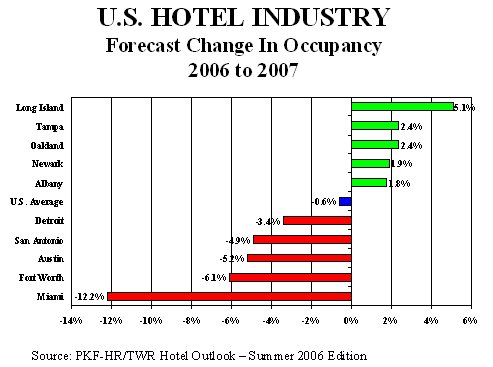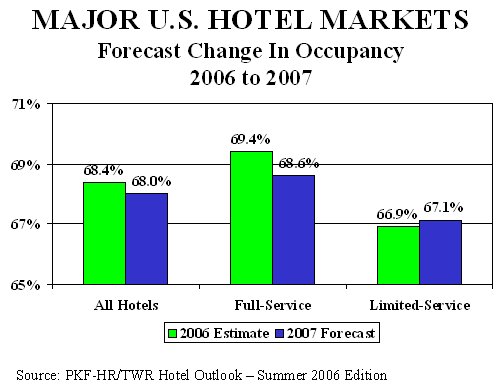|
|
|
But Not Easy, To Find |
| ATLANTA, Ga., July 18, 2006 � After three consecutive years of strong
increases in occupancy, U.S. lodging owners, operators, and guests may
find major city hotel lobbies a little less crowded in 2007. While
the number of hotel rooms occupied will continue to grow at a 1.4 percent
pace, the number of new accommodations is projected to increase by 2.0
percent in 2007. The net result is a forecast of a slight 0.6 percent
decline in occupancy for the nation�s largest lodging markets. This
analysis is based on the summer 2006 edition of Hotel Outlook, an econometric
forecasting model developed by PKF Hospitality Research (PKF-HR) and Torto
Wheaton Research.
�Following three years of strong increases in all industry performance measurements, it would be natural for market participants to assume that such robust times would continue, especially those who are new to the industry,� said R. Mark Woodworth, president of Atlanta-based PKF-HR. �The fact is that we are approaching the peak of the current business cycle, and a slowdown in the pace of growth would not be difficult to imagine. That being said, the U.S. lodging industry is still forecast to realize continued growth in revenues and profits.� Hotel Outlook is an econometric forecasting model developed jointly by PKF-HR and Torto Wheaton Research. The model is based on historical data from Smith Travel Research and economic inputs from economy.com. Hotel Outlook forecasts provide six years of supply, demand, occupancy, average daily rate (ADR), and RevPAR information for 52 major markets across the United States. The data and forecasts are updated each quarter. Occupancy Still Strong While occupancies in U.S. cities are forecast to decline 0.6 percent from 2006 to 2007, the average occupancy rate is still projected to be a healthy 68.0 percent in 2007. This level of performance is well above the long-term average of 66.4 percent. In fact, 68.0 percent occupancy has only been topped five times on the past 18 years. �At 68.0 percent, the average hotel will have a few more rooms available to sell in 2007 versus this year. However, travelers should still expect to face capacity situations in most cities,� Woodworth noted. �While our research shows that the national lodging industry generally follows predictable cycles, it is also true that each individual market�s cycle has its own unique rhythm,� Woodworth said. �Therefore, even with a decline forecast on a national basis, we are projecting that 24 of the 52 cities we track will experience an increase in occupancy during the upcoming year.� Extraordinary events can have an effect on a hotel market�s performance and disrupt traditional performance patterns. �When looking at markets that are forecast to experience the greatest declines in occupancy next year, it is interesting to note that most are located in cities that have been heavily impacted by hurricanes in the past few years. The temporary housing of displaced citizens, relief and construction workers, insurance adjustors, convention delegates, and sporting event spectators has caused artificial ripples in the typical business cycles of several Gulf Coast, Southeast, and South Central lodging markets,� Woodworth observed. Another factor influencing the forecast moderation in occupancy rates is that most cities have reached, or are approaching, their realistic capacity levels. �Based on their historical demand mix and seasonality patterns, markets have established theoretical maximum occupancy thresholds,� Woodworth notes. �Occupancy rates will not continue to grow indefinitely.� |
 |
 |
| Budget Assistance
�Although it is only July, accountants across the nation are busy preparing budgets for 2007,� said Robert Mandelbaum, director of research information services for PKF-HR. �For financial managers at the country�s largest companies, budgeting means putting the pencil to corporate travel expense accounts. Meanwhile, deep in the basements of their properties, hotel controllers are preparing estimates of revenues, expenses, and profits for the upcoming year.� PKF-HR has performed research that reveals that, on average, 70 percent of the performance achieved at the property level is systematically related to the economic health of the metropolitan area in which the hotel is located. Stated differently, on average, only 30 percent of the results ultimately achieved at the unit-level are controlled by property management. �With this in mind, hotels need to have a complete understanding of the direction in which their overall market is heading. Secondary source market forecasts like Hotel Outlook reports can be invaluable tools in helping hotel managers and other interested parties to establish a much more rigorous foundation for their future year operating and travel budgets,� Mandelbaum concludes. * * *
PKF Hospitality Research (PKF-HR), headquartered in Atlanta, is the research affiliate of PKF Consulting, a consulting and real estate firm specializing in the hospitality industry. PKF Consulting has offices in New York, Philadelphia, Washington DC, Atlanta, Indianapolis, Houston, Dallas, Los Angeles, and San Francisco. |
| Contact:
R. Mark Woodworth
|
| Also See: | Summer 2006: Hotels Profit, Guests Pay / June 2006 |
| U.S. Hotels: Revenues and Profits Rise, But So Do Expenses / 2006 Trends in the Hotel Industry / May 2006 |